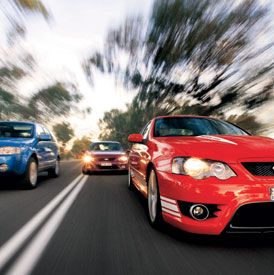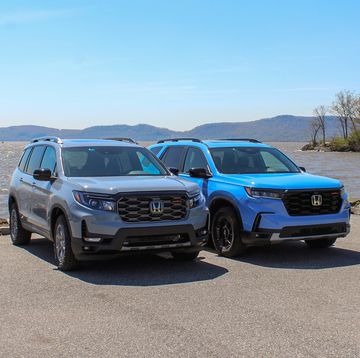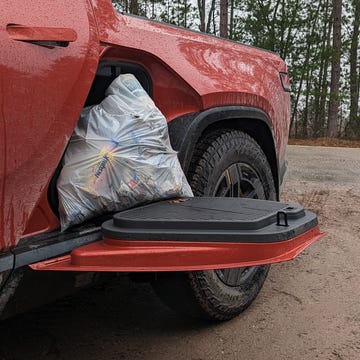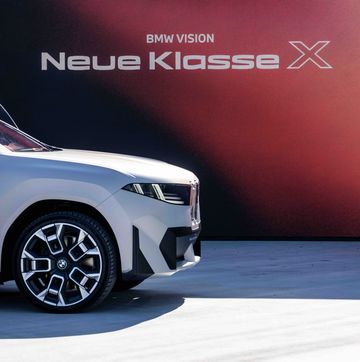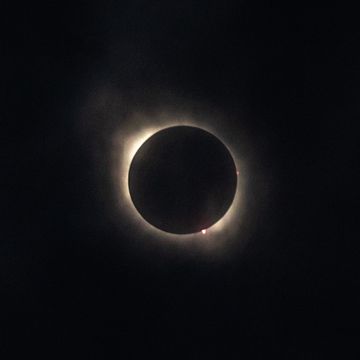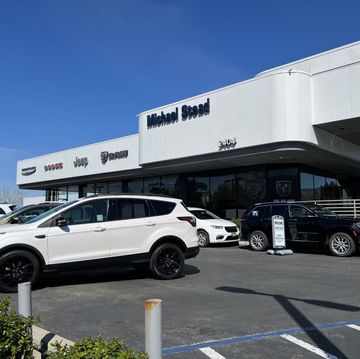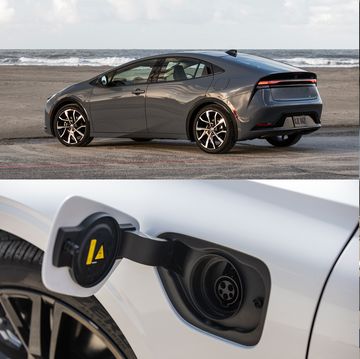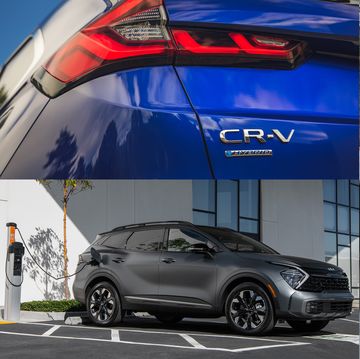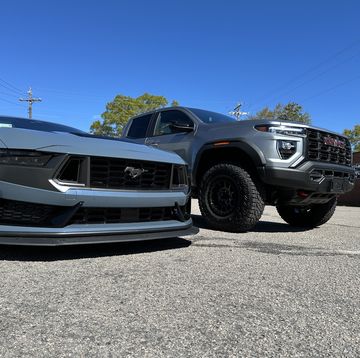For an American automaker, selling a car in the U.S. that was designed for overseas markets is what is known in football as the gadget play. It's the fumblerooski, the Statue of Liberty, the off-the-wall trick call that is highly risky, likely to end in disaster, but may just catch the competition with its drawers dropped. Most times it has been tried — such as in 1984 with the European Ford XR4Ti (it was called a Merkur here) and in 2003 with the Australian-built Pontiac GTO — the results reflected the odds against that play.
Then there was Toyota's Bb, a Japanese-market oldster that tapped a whole new fan base when it reappeared in America as the Scion xB in 2003. GM is about to call its own gadget play by stocking Saturn's shelves with European Opels. We think a little savoir-vivre is just what Saturn needs.
Ford needs something, too. Badly. Bribing America to buy Fords lost the House of Henry $1.6 billion in 2005 even as market share continued to wither. Ford subsequently said it would padlock 14 factories and pink-slip 30,000 workers, gutting one-quarter of its carmaking capacity. In March, a Connecticut dealership that sold Fords for 48 years announced it will switch to Lexus.
We went across the oceans east and west to sniff out Ford's foreign lineup. In distant lands we found a few gems that might just catch everyone by surprise and get Ford a needed touchdown, if it only has the gumption to call the play.
Would you visit a Ford dealer if it sold a budget BMW that hosted five adults and their airport luggage, laid rubber with the rear tires and rode gently on all four, turned sharply into corners and drifted its tail coming out, gave you the choice of a six-speed manual or German-designed six-speed automatic, and came in all the colors of the rainbow and a few found only in a toxic dump?
To borrow an Aussie phrase, we bet the Ford Falcon would stick out in America like dogs' balls. And that's a good thing.
Enduring the 15-hour flight to Melbourne is like jumping into America's parallel reality. In Melbourne — or "Mel-boring" to Sydneysiders — the suburbs of red-brick cottages on one-third-acre lots have the ambience of Anytown, U.S.A. Australians drive their kids to school, shop in fluorescent-lit supermarkets, keep the A/C on high, and eat too much partially hydrogenated vegetable oil. If we're going to find America's next sweetheart car, this is the place.
We're headed into the grassy flatlands southwest of Melbourne — in fact, to some of the very locations where the Australian cops-versus-bikers flick Mad Max launched Mel Gibson's career and committed some of filmography's best vehicle carnage to celluloid — in two versions of Ford's 2006 Falcon. The XR6 Turbo and the V-8-powered FPV GT are the top tire smokers of this big, lovable lineup of rear-drive family sedans (and wagons and "utes," for the platform is used in all three).
They have supportive buckets providing heaps of head- and legroom, well-executed interiors lined in matte-finish soft plastics and precision-guided buttons, and sizzling jolts of power headed to the rear where jolting power belongs. Somehow, Australia has become the place to find the quintessential American muscle sedan.
The Falcon has always swung by a shoestring. In a tiny market of about one million new cars per year, Ford sold 53,080 Falcons last year, a fragile number that has somehow weathered a flood of imports and a few colossal mistakes. Many Australians never forgave Ford for axing the optional V-8 in 1983 (it came back in 1991). A disastrous 1998 redesign that Aussies dubbed the "cockroach" followed Ford's introduction of the Taurus to Australia — one of several failed attempts to replace the Falcon with a U.S.- or European-sourced car. Buyers, including most police agencies, left for GM's Holden in droves.
Instead of folding the Falcon, Ford retooled it. Athletic proportions and a pugnacious face returned some Aussie swagger to the Falcon in 2004. The 2006 Falcon BF (so designated after the local habit of assigning new models a two-letter code name) also comes with a wide choice of performance upgrades and a fresh palate of blazing colors. This year, uplevel Falcons also shed their old four-speed automatics for a new ZF 6HP26 six-speed — a state-of-the-art autobox fitted to BMWs and to a seven-seat sport-utility called the Ford Territory, launched into the Australian market on the Falcon platform in 2005.
Australia fancies its sport-utes despite fuel prices of $3.50 a gallon and a widespread antipathy among city dwellers for the Australian Outback, which is about the size of America's lower 48 states. In size, the Territory (23,454 sold in 2005) just squeezes in between the slightly larger Ford Freestyle and slightly smaller Ford Escape, coupling adult-ample front and middle rows with a tykes-only third row. The loaded Territory Ghia all-wheel-drive is $40,302, or start with the base TX with rear drive for $28,283.
With 255 horsepower from a 4.0-liter inline-six, the 4700-pound four-wheel-drive Territory accelerates about as fiercely as tree sap (a turbo version blows in this year). It scribes a nice curve, however, has a dapper cockpit, and generally feels more elegant and balanced than the front-driver-based Freestyle. For that, the Territory owes much to its chassis donor, the Falcon.
Melbourne's highways, which have a 100km/h speed limit — or 62 mph — zealously enforced by speed cameras (our local guide complained of receiving a ticket for 106km/h, or 3.7 mph over), fairly sparkle with eye-frying reds, electric blues, citrus greens, and grape-juice purples painted on brand-new BFs, and it seems as if every other Falcon has a sporty XR trim. The base $24,985 Falcon (not including Australia's various taxes) and the $28,444 XR6 use a 255-hp, 4.0-liter dual-cam 24-valve inline-six. Cast mostly in iron and predating unleaded fuel, this smooth workhorse has been updated in recent years with an aluminum cylinder head, variable valve timing on both cams, and dual-length intake plenums. Australia is the only place you'll see it.
The $33,195 XR6 Turbo is the same engine pressurized by a huge Garrett turbine to make 329 horsepower. The $36,751 XR8 has the heart of a Navigator, specifically, the 5.4-liter DOHC 32-valve V-8 making 349 horses. The alpha Falcon is the $44,506 (before luxury taxes) FPV GT Boss 290, developed by Ford-Australia's in-house tuning unit, Ford Performance Vehicles. The GT makes 389 horsepower and 384 pound-feet of torque and is recognized by its brazen "Boss 290" hood decals (a reference to the kilowatt equivalent of 389 horsepower).
For many Aussies, especially those who own imports, the GT with its gaping chin scoop and virile hood bulge is pure bogan. That's Aussie for "redneck." But owning a V-8 in Australia does come with bragging rights, due largely to the country's V-8 Supercar racing series, a perennial grudge match between Ford and Holden.
Down the lonely blacktop that played "Anarchie Road" in Mad Max, our GT reeled in the horizon with a roar from its twin exhausts. The ride leans to squishy, although the all-independent suspension manages 4100 pounds of car with impressive control. Stops are executed fast and without fade by red Brembo calipers on cross-drilled rotors. Only two complaints surfaced: The steering is numb, and the V-8 makes low-end torque as if assembled from two Honda four-cylinders.
The XR6 Turbo, 300 pounds lighter, is the Falcon's sweetest flavor. The torque slides in remarkably low and, according to an Australian car magazine, actually clips a couple of 10ths off the GT's 6.5-second 0-to-60-mph sprint. Yes, the turbo model is cheaper and faster. Naturally balanced by Newtonian physics, this pressure-fed inline-six is one smooth operator. Let loose in America, we reckon the XR6 Turbo would make Ford showrooms mandatory destinations for every sports-sedan buyer on a budget. And wouldn't that just be fair dinkum?
Within Ford, the United States evidently isn't a part of the known world. FoMoCo trumpets an industrial strategy called "Global Shared Technologies," which aims to use the resources and expertise of the many companies under the Ford umbrella to create a basket of features and component sets that can be mixed and matched for each marque. The major vehicle in the first application of this system is the European Ford Focus, which shares its platform with the Mazda 3 and Volvo S40. The Mazda and the Volvo are already sold in the U.S., but the second-generation Focus, introduced in Europe in 2004, is not. Global, it seems, is a misnomer.
That's a pity for Americans, as the new Focus is Ford of Europe's best car — in sales and in the way it drives. The original Focus, which lives on in the U.S., set a new standard in its class when it first appeared, but that was eight years ago and the market has changed. Customers demand more, even from the smallest and cheapest cars.
The European Focus delivers more — it has a bigger and stiffer body shell, refinements to the four-wheel independent suspension, speed-variable electrohydraulic power steering, bigger brakes, more safety equipment, and a smarter cabin. About the only thing that isn't improved — at least in our eyes — is the styling of the hatchback versions that are most popular in Europe.
The latest and greatest Euro Focus is the ST model, a sparkling performer that takes on some very hot hatchbacks — such as the Volkswagen Golf GTI and Opel Astra OPC — and wins.
Global Shared Technologies has provided the Focus ST with a 2.5-liter turbocharged five-cylinder engine from Volvo. This 222-hp motor has variable timing for both camshafts, which assists it in achieving the maximum 236 pound-feet of torque from 1600 rpm. The result is a car that is faster (150 mph) than the more extreme Focus RS of the previous generation but also smoother and better behaved.
This time Ford's Team RS, which develops all the European high-performance models, took the Focus hatchback — three- and five-door cars are available — and fitted 30-percent-stiffer springs and a strut brace in front, added new shocks and a thicker anti-roll bar at the rear, and made the steering eight percent quicker. We have experienced the benefit of this careful development on the road and at Le Castellet circuit in the south of France. The ST, which does without four-wheel drive or a limited-slip differential, has tenacious grip, and it handles and steers with precision. It is quick (Ford claims a believable 0-to-60 time of 6.5 seconds), copes with full power out of a tight corner without twitching the steering, has terrific brakes, and makes a suitably powerful noise.
Ford says the problem with the second-generation Focus is that it has grown too big, acquired too much expensive equipment, and generally become too posh to be sold as an entry-level model in the U.S. But we guess that American drivers who eagerly adopted the 170-hp SVT Focus would love the ST and would be willing to pay a premium for such a civilized rocket ship. If Ford could sell this car here for about $22,000 (that's not as far from the U.K. price as you might think, because baked into the $30,575 price is a hefty 17.5-percent tax and the currently unfavorable dollar-to-pound ratio), the company would have a sure winner.
Badger a Ford exec about why these lively cars aren't sold in America, and you'll hear about prohibitive federal regs and wrong features and bad pricing. Ford's president of international operations, Mark Schulz, says of an American Falcon that "you can't dismiss the idea altogether. We're always looking at our global product portfolio, and our global engineering teams are working more closely than ever now." But he calls it "unlikely," as the company has already made different plans for America. "There are a number of good, bold products in the pipeline already developed for the U.S. market, and those will hit the mark, just as the Falcon has in Australia." But at a time when Ford's U.S. operations are top heavy with practical models like the Fusion and the Edge, the Five Hundred and the Freestyle, these machines would certainly add spice to that workaday lineup.
The fact that they're niche models is precisely why Ford needs to figure out a way to bring them to America and sell them at a profit. Because as difficult as they might be to import, surely that is a less expensive solution than developing separate limited-production vehicles dedicated to the American market alone.
S-Max
The S-Max, which goes on sale in Europe this summer, is another product that we could see making it across the Atlantic. Based off the same corporate-components set as the new Volvo S80, the front-wheel-drive minivan has seating for seven in a stylish, appealing compact body shell. Mazda, aided and abetted by rising gas prices, has shown that there is a (limited) market for mini-minivans. Of course, Ford cries cost, but Mazda seems to be able to import small cars from Japan and make a profit.
Ranchero
We once called them Rancheros, but to Australians they're just "utes." Part sedan, part pickup truck, fully Australian, utes are the country's mules of commerce, hauling everything from livestock in the Outback to tools and supplies for inner-city tradesmen. Ford offers a crew-cab Falcon ute, and aluminum flatbeds are a popular option. Used utes are often a young driver's first car, and the cheapest Falcon is a ute, starting at $19,286 and ranging up to $30,000 for a V-8 with leather seats, navigation, and an aero kit.
The F6 Typhoon and V-8 Pursuit ute are bogan Ferraris. Low-slung and rarely seen anywhere except on city streets, these super-utes are tuned by Ford Performance Vehicles into two-seat tire roasters. They break it loose early and often with up to 349 horsepower. With a low center of gravity, they handle far better than any American-sized pickup.
The last Ranchero was sold in 1979. Perhaps it's time Ford did a new ute reboot in America.
FORD FALCON XR6 TURBO
VEHICLE TYPE: front-engine, rear-wheel-drive, 5-passenger, 4-door sedan
BASE PRICE (Australia): $33,195
ENGINE TYPE: turbocharged and intercooled DOHC 24-valve inline-6, iron block and aluminum head, port fuel injection
Displacement: 243 cu in, 3983cc
Power (SAE net): 329 bhp @ 5250 rpm
Torque (SAE net): 354 lb-ft @ 2000 rpm
TRANSMISSIONS" 6-speed automatic with manumatic shifting, 6-speed manual
DIMENSIONS:
Wheelbase: 111.4 in Length: 193.5 in Width: 73.4 in Height: 56.9 in
Curb weight: 3800 lb
PERFORMANCE RATINGS ( C/D est, 6-sp auto):
Zero to 60 mph: 6.2 sec
Standing ¼-mile: 14.3 sec
FUEL ECONOMY (6-sp auto):
C/D-observed: 17 mpg
FORD FALCON FPV GT BOSS 290
VEHICLE TYPE: front-engine, rear-wheel-drive, 5-passenger, 4-door sedan
BASE PRICE (Australia): $44,506
ENGINE TYPE: DOHC 32-valve V-8, iron block and aluminum heads, port fuel injection
Displacement: 330 cu in, 5409cc
Power (SAE net): 389 bhp @ 5500 rpm
Torque (SAE net): 384 lb-ft @ 4500 rpm
TRANSMISSIONS: 6-speed automatic with manumatic shifting, 6-speed manual
DIMENSIONS:
Wheelbase: 111.4 in Length: 194.6 in Width: 73.4 in Height: 56.9 in
Curb weight: 4100 lb
PERFORMANCE RATINGS ( C/D est, 6-sp auto):
Zero to 60 mph: 6.4 sec
Standing ¼-mile: 14.4 sec
FUEL ECONOMY (6-sp auto):
C/D-observed: 14 mpg
FORD TERRITORY GHIA AWD
VEHICLE TYPE: front-engine, 4-wheel-drive, 7-passenger, 5-door wagon
BASE PRICE (Australia): $40,302
ENGINE TYPE: DOHC 24-valve inline-six, iron block and aluminum head, port fuel injection
Displacement: 243 cu in, 3983cc
Power (SAE net): 255 bhp @ 5250 rpm
Torque (SAE net): 283 lb-ft @ 2500 rpm
TRANSMISSION: 6-speed automatic with manumatic shifting
DIMENSIONS:
Wheelbase: 111.9 in Length: 191.2 in Width: 74.7 in Height: 67.5 in
Curb weight: 4700 lb
PERFORMANCE RATINGS ( C/D est):
Zero to 60 mph: 9.4 sec
Standing ¼-mile: 16.9 sec
FUEL ECONOMY (6-sp auto):
C/D-observed: 15 mpg
FORD FOCUS ST
VEHICLE TYPE: front-engine, front-wheel-drive, 5-passenger, 3-5-door coupe or sedan
BASE PRICE (U.K.): $30,575
ENGINE TYPE: turbocharged and intercooled DOHC 20-valve inline-5, aluminum block and head, port fuel injection
Displacement: 154 cu in, 2521cc
Power (SAE net): 222 bhp @ 6000 rpm
Torque (SAE net): 236 lb-ft @ 1600 rpm
TRANSMISSION: 6-speed manual
DIMENSIONS:
Wheelbase: 103.9 in Length: 171.7 in Width: 72.4 in Height: 57.0 in
Curb weight: 3100-3200 lb
PERFORMANCE RATINGS (mfr's est):
Zero to 60 mph: 6.5 sec
Top speed (drag limited): 150 mph
PROJECTED FUEL ECONOMY ( C/D est):
EPA city driving: 22 mpg
EPA highway driving: 31 mpg
